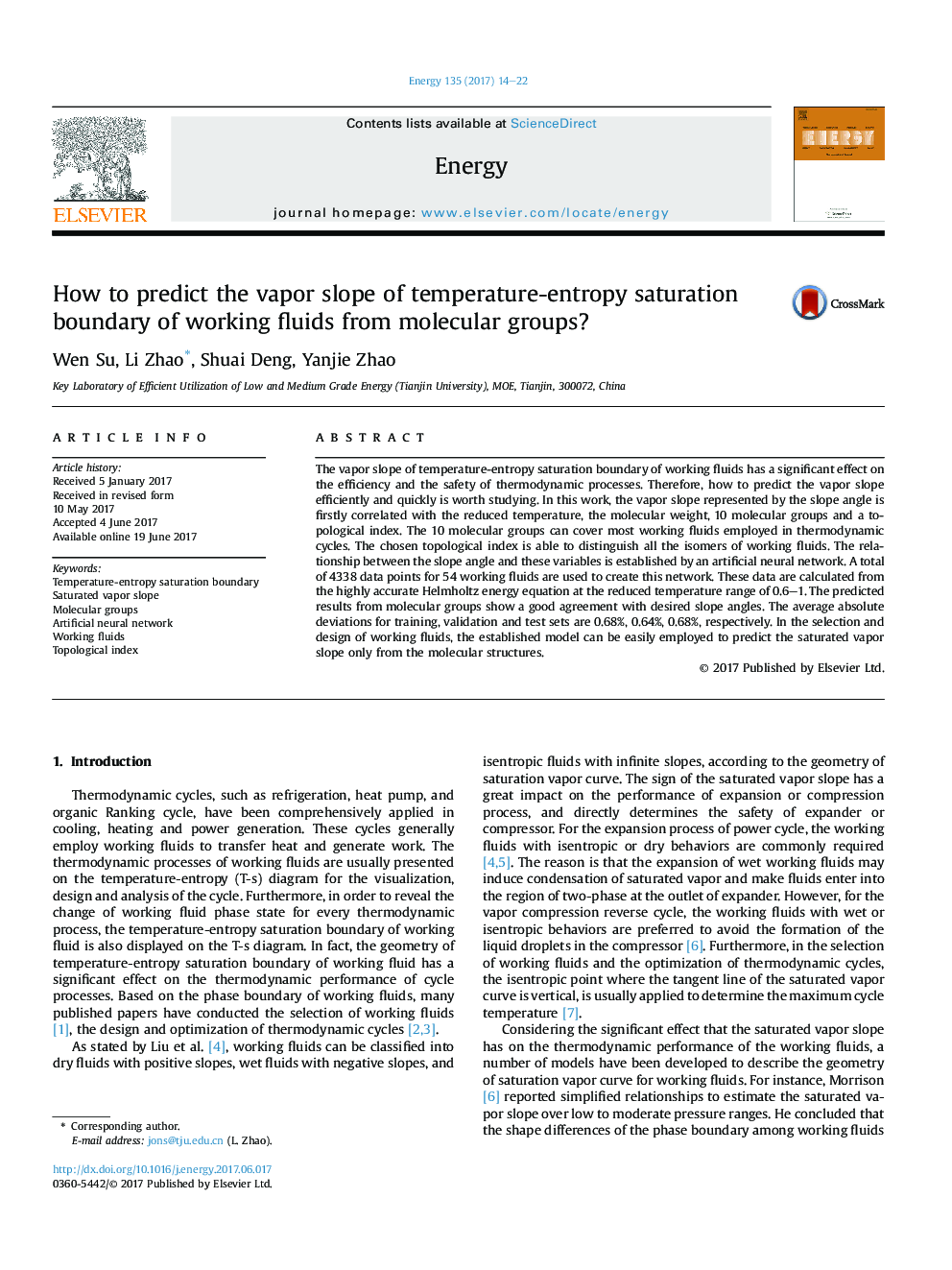| کد مقاله | کد نشریه | سال انتشار | مقاله انگلیسی | نسخه تمام متن |
|---|---|---|---|---|
| 5476374 | 1521416 | 2017 | 9 صفحه PDF | دانلود رایگان |
عنوان انگلیسی مقاله ISI
How to predict the vapor slope of temperature-entropy saturation boundary of working fluids from molecular groups?
ترجمه فارسی عنوان
چگونه می توان پیش بینی شیب بخار از مرز اشباع دمای آنتروپی را از مایعات کار از گروه های مولکولی؟
دانلود مقاله + سفارش ترجمه
دانلود مقاله ISI انگلیسی
رایگان برای ایرانیان
کلمات کلیدی
مرز اشباع آنتروپی دما، شیب پراش اشباع شده، گروه های مولکولی، شبکه های عصبی مصنوعی، مایع کار، شاخص توپولوژیک،
ترجمه چکیده
شیب بخار مرز اشباع آنتروپی دمای آن از مایعات کار تاثیر قابل توجهی بر کارایی و ایمنی فرایندهای ترمودینامیکی دارد. بنابراین، چگونگی پیش بینی شیب بخار به صورت موثر و سریع، ارزش مطالعه دارد. در این کار، شیب بخار نشان دهنده ی زاویه ی شیب است که ابتدا با دمای کاهش ی، وزن مولکولی، 10 گروه مولکولی و یک شاخص توپولوژیکی مرتبط است. گروه های 10 مولکولی می توانند بیشترین مایعات کار را که در دوره های ترمودینامیکی کار می کنند را پوشش دهند. شاخص توپولوژیکی انتخاب شده قادر به تشخیص تمام ایزومرهای مایعات کار شده است. رابطه بین زاویه شیب و این متغیرها توسط یک شبکه عصبی مصنوعی ایجاد شده است. در مجموع 4338 نقطه داده برای 54 مایعات کار می کنند برای ایجاد این شبکه استفاده می شود. این داده ها از معادله انرژی هلمولتز بسیار دقیق در محدوده دما 0.6-1 کاهش یافته است. نتایج پیش بینی شده از گروه های مولکولی توافق خوب با زاویه شیب مطلوب را نشان می دهد. میانگین انحراف مطلق برای آموزش، اعتبارسنجی و مجموعه آزمون به ترتیب 0.68، 0.64 و 0.68 درصد است. در انتخاب و طراحی مایعات کار، مدل پایه را می توان به راحتی برای پیش بینی شیب بخار اشباع تنها از ساختار مولکولی استفاده کرد.
موضوعات مرتبط
مهندسی و علوم پایه
مهندسی انرژی
انرژی (عمومی)
چکیده انگلیسی
The vapor slope of temperature-entropy saturation boundary of working fluids has a significant effect on the efficiency and the safety of thermodynamic processes. Therefore, how to predict the vapor slope efficiently and quickly is worth studying. In this work, the vapor slope represented by the slope angle is firstly correlated with the reduced temperature, the molecular weight, 10 molecular groups and a topological index. The 10 molecular groups can cover most working fluids employed in thermodynamic cycles. The chosen topological index is able to distinguish all the isomers of working fluids. The relationship between the slope angle and these variables is established by an artificial neural network. A total of 4338 data points for 54 working fluids are used to create this network. These data are calculated from the highly accurate Helmholtz energy equation at the reduced temperature range of 0.6-1. The predicted results from molecular groups show a good agreement with desired slope angles. The average absolute deviations for training, validation and test sets are 0.68%, 0.64%, 0.68%, respectively. In the selection and design of working fluids, the established model can be easily employed to predict the saturated vapor slope only from the molecular structures.
ناشر
Database: Elsevier - ScienceDirect (ساینس دایرکت)
Journal: Energy - Volume 135, 15 September 2017, Pages 14-22
Journal: Energy - Volume 135, 15 September 2017, Pages 14-22
نویسندگان
Wen Su, Li Zhao, Shuai Deng, Yanjie Zhao,
